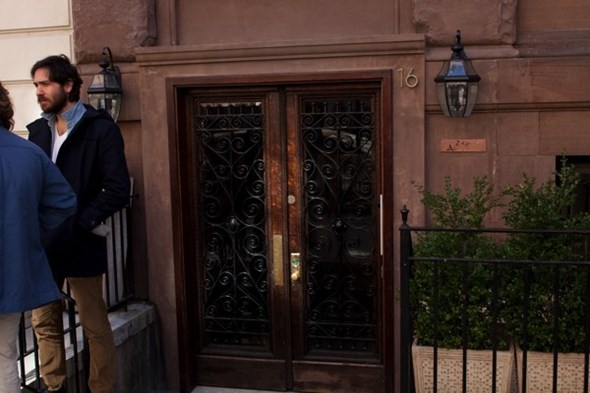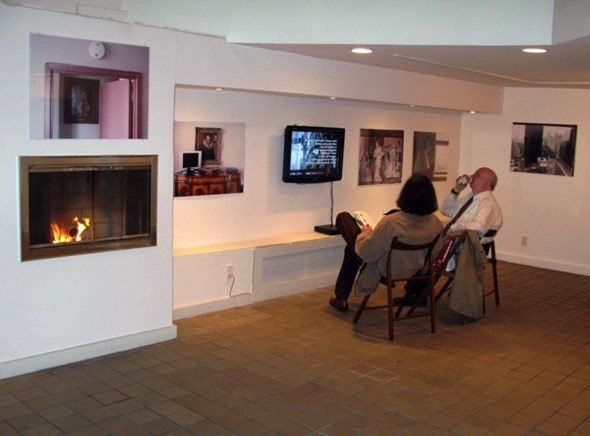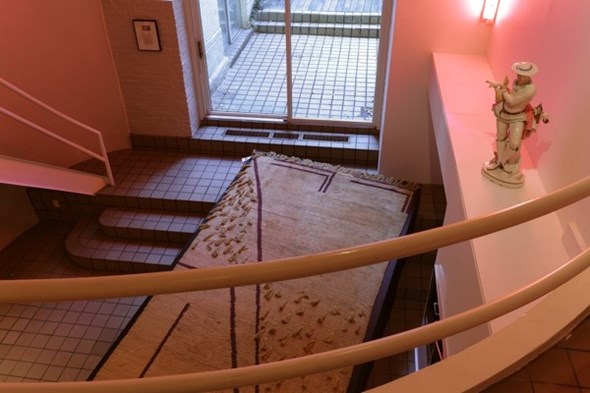
Alex Zachary in front of his gallery
Alex Zachary, New York City
About a year ago, Alex Zachary opened a gallery on the Upper East Side, a place few would expect to find a young gallerist, rubbing shoulders with old money and just a stone’s throw from the major museums. By Gianni Jetzer
Alex Zachary doesn’t play by the book. He studied Greek Classics, but abandoned academia in search of something a little more cutting edge. He landed his first paid job as a receptionist at Gavin Brown’s gallery, one of the city’s top addresses for offbeat projects. Quickly working his way up, his achievements included the completion, under huge time pressure, of Urs Fischer’s installation You, for which the artist had a three-metre deep pit excavated in the gallery. With that, he proved that even within the commercial art world of a city notorious for its red tape, anything – or almost anything – is possible. Yet even this was too humdrum for Zachary. He wanted a gallery for his own generation, but he didn’t want to be just a junior version of Gavin Brown, nor did he have any ambition to open yet another gallery in the Lower East Side. He had his sights on the upmarket Upper East Side (where he grew up), which was something of a blind spot in the contemporary art scene. The place he was eventually offered in Manhattan’s crisis-ridden real estate market more or less forced his hand. From the outside, there is nothing to indicate the quirkiness of what lies within. A well-known design importer had purchased the property in 1979 and renovated the basement and ground floor to create a futuristic urban residence. The rooms are a challenge for any artist, even today, and Zachary candidly admits that they actually shape the program. Not everything is possible here, but a lot of what is created would be impossible elsewhere.

Exhibition view, Rainer Ganahl »Language of Emigration & Pictures of Emigration«, 2010

Exhibition view »Bloodflames III«, curated by Nick Mauss, 2010
Rainer Ganahl (*1961) installed seven monitors in the empty gallery for his Spring 2010 exhibition Language of Emigration & Pictures of Emigration. Each showed an interview with German-speaking immigrants who had made their home in America. Their stories, from the traumatic to the banal, weave a tapestry of memory, while the homes of the interviewees in the films and photos become an object-like portrayal of their biographies. The gallery provided the perfect setting, for its former life as an apartment is evident in spite of the lack of furniture. In the New York Times, Roberta Smith lauded Ganahl’s exhibition as the high point of an extraordinary career.
Zachary is reluctant to single out any particular gallerists as role models. However, he does point out that he aims to have a program that places the focus on the artists themselves rather than the gallerist. He prefers to quietly pull strings in the background, that includes inviting guest curators. Recently, the young American artist Nick Mauss created a group exhibition, Bloodflames III, the title of which refers to a 1947 Surrealist exhibition. Mauss extended the show to include theatre, architecture and design as well as art. Handwritten notes by singer Antony Hegarty on Jean Genet’s debut novel Notre-Dame-
des-Fleurs were juxtaposed with a kitsch Nymphenburg porcelain figurine. A hand-knotted rug by Evelyn Wyld graced the two-storey living room, in close proximity to some small pottery busts created in the 20s by Eyre de Lanux, who was Wyld’s lover at the time. The artist-curator brought together some of his favourite pieces, many of which he had never before seen in the original, as he stated in the press release.
After taking a close look at Zachary’s business philosophy, the question arises as to why he actually opened a gallery rather than, say, an off-space. His answer is unequivocal. He envisages supporting artists over a considerable period of time and assisting them in the production of unusual projects. The long-term relationship between gallerist and artist is better suited to that approach than institutional curating. Zachary visits several studios every month, but rarely finds what he is looking for. For the most part, he gets his information from artist friends such as Ken Okiishi, who had the opening exhibition at the gallery and created the logo together with Nick Mauss.
The gallery changes on a daily basis, as Zachary notes with satisfaction. The quirky space is his for two years. What happens after that, he doesn’t say.
Translated by Ishbel Flett
GIANNI JETZER is director of the Swiss Institute in New York City. GIANNI JETZER
Alex Zachary
16 East 77th Street
New York City
front@alexzachary.com
www.alexzachary.com
Zachary is reluctant to single out any particular gallerists as role models. However, he does point out that he aims to have a program that places the focus on the artists themselves rather than the gallerist. He prefers to quietly pull strings in the background, that includes inviting guest curators. Recently, the young American artist Nick Mauss created a group exhibition, Bloodflames III, the title of which refers to a 1947 Surrealist exhibition. Mauss extended the show to include theatre, architecture and design as well as art. Handwritten notes by singer Antony Hegarty on Jean Genet’s debut novel Notre-Dame-
des-Fleurs were juxtaposed with a kitsch Nymphenburg porcelain figurine. A hand-knotted rug by Evelyn Wyld graced the two-storey living room, in close proximity to some small pottery busts created in the 20s by Eyre de Lanux, who was Wyld’s lover at the time. The artist-curator brought together some of his favourite pieces, many of which he had never before seen in the original, as he stated in the press release.
After taking a close look at Zachary’s business philosophy, the question arises as to why he actually opened a gallery rather than, say, an off-space. His answer is unequivocal. He envisages supporting artists over a considerable period of time and assisting them in the production of unusual projects. The long-term relationship between gallerist and artist is better suited to that approach than institutional curating. Zachary visits several studios every month, but rarely finds what he is looking for. For the most part, he gets his information from artist friends such as Ken Okiishi, who had the opening exhibition at the gallery and created the logo together with Nick Mauss.
The gallery changes on a daily basis, as Zachary notes with satisfaction. The quirky space is his for two years. What happens after that, he doesn’t say.
Translated by Ishbel Flett
GIANNI JETZER is director of the Swiss Institute in New York City. GIANNI JETZER
Alex Zachary
16 East 77th Street
New York City
front@alexzachary.com
www.alexzachary.com
